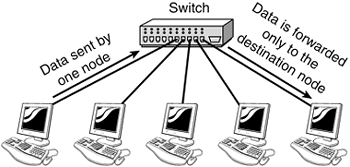Switches
Like hubs, switches are the connectivity points of an Ethernet network. Devices connect to switches via twisted-pair cabling, one cable for each device. The difference between hubs and switches is in how the devices deal with the data that they receive. Whereas a hub forwards the data it receives to all of the ports on the device, a switch forwards it only to the port that connects to the destination device. It does this by learning the MAC address of the devices attached to it, and then by matching the destination MAC address in the data it receives. Figure 1 shows how a switch works.
Figure 1 How a switch works.
By forwarding data only to the connection that should receive it, the switch can improve network performance in two ways. First, by creating a direct path between two devices and controlling their communication, it can greatly reduce the number of collisions on the network. As you might recall, collisions occur on Ethernet networks when two devices attempt to transmit at exactly the same time. In addition, the lack of collisions enables switches to communicate with devices in full-duplex mode. In a full-duplex configuration, devices can send and receive data from the switch at the same time. Contrast this with half-duplex communication, in which communication can occur in only one direction at a time. Full-duplex transmission speeds are double that of a standard, half-duplex, connection. So, a 10Mbps connection becomes 20Mbps, and a 100Mbps connection becomes 200Mbps.
The net result of these measures is that switches can offer significant performance improvements over hub-based networks, particularly when network use is high.
Irrespective of whether a connection is at full or half duplex, the method of switching dictates how the switch deals with the data it receives. The following is a brief explanation of each method:
-
Cut-through In a cut-through switching environment, the packet begins to be forwarded as soon as it is received. This method is very fast, but creates the possibility of errors being propagated through the network, as there is no error checking.
-
Store-and-forward Unlike cut-through, in a store-and-forward switching environment, the entire packet is received and error checked before being forwarded. The upside of this method is that errors are not propagated through the network. The downside is that the error checking process takes a relatively long time, and store-and-forward switching is considerably slower as a result.
-
FragmentFree To take advantage of the error checking of store-and-forward switching, but still offer performance levels nearing that of cut-through switching, FragmentFree switching can be used. In a FragmentFree-switching environment, enough of the packet is read so that the switch can determine whether the packet has been involved in a collision. As soon as the collision status has been determined, the packet is forwarded.